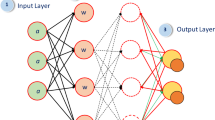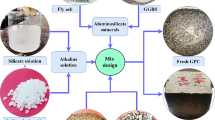Abstract
This study examined the feasibility of using the grey wolf optimizer (GWO) and artificial neural network (ANN) to predict the compressive strength (CS) of self-compacting concrete (SCC). The ANN-GWO model was created using 115 samples from different sources, taking into account nine key SCC factors. The validation of the proposed model was evaluated via six indices, including correlation coefficient (R), mean squared error, mean absolute error (MAE), IA, Slope, and mean absolute percentage error. In addition, the importance of the parameters affecting the CS of SCC was investigated utilizing partial dependence plots. The results proved that the proposed ANN-GWO algorithm is a reliable predictor for SCC’s CS. Following that, an examination of the parameters impacting the CS of SCC was provided.
Similar content being viewed by others
References
Neville A M, Adam M. Properties of Concrete. Pearson, 2011
Kovler K, Roussel N. Properties of fresh and hardened concrete. Cement and Concrete Research, 2011, 41(7): 775–792
Wiktor V, Jonkers H M. Quantification of crack-healing in novel bacteria-based self-healing concrete. Cement and Concrete Composites, 2011, 33(7): 763–770
Kan A, Demirboğa R. A novel material for lightweight concrete production. Cement and Concrete Composites, 2009, 31(7): 489–495
Houst Y F, Bowen P, Perche F, Kauppi A, Borget P, Galmiche L, Le Meins J F, Lafuma F, Flatt R J, Schober I, Banfill P F G, Swift D S, Myrvold B O, Petersen B G, Reknes K. Design and function of novel superplasticizers for more durable high performance concrete (superplast project). Cement and Concrete Research, 2008, 38(10): 1197–1209
Okamura H. Self-compacting high-performance concrete. Concrete International, 1997, 19: 50–54
K. OZAWA. High-performance concrete based on the durability design of concrete structures. In: Proceedings of the Second East Asia-Pacific Conference on Structural Engineering and Construction. 1989
Domone P L. A review of the hardened mechanical properties of self-compacting concrete. Cement and Concrete Composites, 2007, 29(1): 1–12
Shi C, Wu Z, Lv K, Wu L. A review on mixture design methods for self-compacting concrete. Construction & Building Materials, 2015, 84: 387–398
Okamura H, Ouchi M. Self-compacting concrete. Journal of Advanced Concrete Technology, 2003, 1(1): 5–15
Domone P L. Self-compacting concrete: An analysis of 11 years of case studies. Cement and Concrete Composites, 2006, 28(2): 197–208
Brouwers H J H, Radix H J. Self-compacting concrete: Theoretical and experimental study. Cement and Concrete Research, 2005, 35(11): 2116–2136
Shi C, Yanzhong W. Mixture proportioning and properties of self-consolidating lightweight concrete containing glass powder. ACI Materials Journal, 2005, 102: 355–363
Haach V G, Vasconcelos G, Lourenço P B. Influence of aggregates grading and water/cement ratio in workability and hardened properties of mortars. Construction & Building Materials, 2011, 25(6): 2980–2987
Molero M, Segura I, Izquierdo M A G, Fuente J V, Anaya J J. Sand/cement ratio evaluation on mortar using neural networks and ultrasonic transmission inspection. Ultrasonics, 2009, 49(2): 231–237
Okamura H, Ozawa K, Ouchi M. Self-compacting concrete. Structural Concrete, 2000, 1(1): 3–17
Esmaeilkhanian B, Khayat K H, Yahia A, Feys D. Effects of mix design parameters and rheological properties on dynamic stability of self-consolidating concrete. Cement and Concrete Composites, 2014, 54: 21–28
Yaşar E, Erdoğan Y, Kılıç A. Effect of limestone aggregate type and water-cement ratio on concrete strength. Materials Letters, 2004, 58(5): 772–777
Uysal M, Tanyildizi H. Estimation of compressive strength of self compacting concrete containing polypropylene fiber and mineral additives exposed to high temperature using artificial neural network. Construction & Building Materials, 2012, 27(1): 404–414
Sathyan D, Anand K B, Prakash A J, Premjith B. Modeling the fresh and hardened stage properties of self-compacting concrete using random kitchen sink algorithm. International Journal of Concrete Structures and Materials, 2018, 12(1): 1–10
Sonebi M. Applications of statistical models in proportioning medium-strength self-consolidating concrete. ACI Materials Journal, 2004, 101(5): 339–346
Sonebi M. Medium strength self-compacting concrete containing fly ash: Modelling using factorial experimental plans. Cement and Concrete Research, 2004, 34(7): 1199–1208
Vu-Bac N, Lahmer T, Keitel H, Zhao J, Zhuang X, Rabczuk T. Stochastic predictions of bulk properties of amorphous polyethylene based on molecular dynamics simulations. Mechanics of Materials, 2014, 68: 70–84
Vu-Bac N, Lahmer T, Zhang Y, Zhuang X, Rabczuk T. Stochastic predictions of interfacial characteristic of polymeric nanocomposites (PNCs). Composites. Part B, Engineering, 2014, 59: 80–95
Vu-Bac N, Silani M, Lahmer T, Zhuang X, Rabczuk T. A unified framework for stochastic predictions of mechanical properties of polymeric nanocomposites. Computational Materials Science, 2015, 96: 520–535
Vu-Bac N, Rafiee R, Zhuang X, Lahmer T, Rabczuk T. Uncertainty quantification for multiscale modeling of polymer nanocomposites with correlated parameters. Composites. Part B, Engineering, 2015, 68: 446–464
Guo H, Zhuang X, Rabczuk T. A deep collocation method for the bending analysis of Kirchhoff plate. Computers, Materials & Continua, 2019, 59(2): 433–456
Samaniego E, Anitescu C, Goswami S, Nguyen-Thanh V M, Guo H, Hamdia K, Zhuang X, Rabczuk T. An energy approach to the solution of partial differential equations in computational mechanics via machine learning: Concepts, implementation and applications. Computer Methods in Applied Mechanics and Engineering, 2020, 362: 112790
Guo H, Zhuang X, Chen P, Alajlan N, Rabczuk T. Stochastic deep collocation method based on neural architecture search and transfer learning for heterogeneous porous media. Engineering with Computers, 2022, 1–26
Guo H, Zhuang X, Chen P, Alajlan N, Rabczuk T. Analysis of three-dimensional potential problems in non-homogeneous media with physics-informed deep collocation method using material transfer learning and sensitivity analysis. Engineering with Computers, 2022, 1–22
Liu B, Vu-Bac N, Zhuang X, Fu X, Rabczuk T. Stochastic full-range multiscale modeling of thermal conductivity of polymeric carbon nanotubes composites: A machine learning approach. Composite Structures, 2022, 289: 115393
Liu B, Vu-Bac N, Rabczuk T. A stochastic multiscale method for the prediction of the thermal conductivity of polymer nanocomposites through hybrid machine learning algorithms. Composite Structures, 2021, 273: 114269
Anitescu C, Atroshchenko E, Alajlan N, Rabczuk T. Artificial neural network methods for the solution of second order boundary value problems. Computers, Materials & Continua, 2019, 59(1), 345–359
Dao D V, Ly H B, Trinh S H, Le T T, Pham B T. Artificial intelligence approaches for prediction of compressive strength of geopolymer concrete. Materials (Basel), 2019, 12(6): 983
Ly H B, Pham B T, Dao D V, Le V M, Le L M, Le T T. Artificial intelligence approaches for prediction of compressive strength of geopolymer concrete. Materials (Basel), 2019, 12(6): 3841
Le T H, Nguyen H L, Pham B T, Nguyen M H, Pham C T, Nguyen N L, Le T T, Ly H B. Artificial intelligence-based model for the prediction of dynamic modulus of stone mastic asphalt. Applied Sciences, 2020, 10(15), 5242.
Sebastiá M, Fernández Olmo I, Irabien A. Neural network prediction of unconfined compressive strength of coal fly ash-cement mixtures. Cement and Concrete Research, 2003, 33(8): 1137–1146
Lee S C. Prediction of concrete strength using artificial neural networks. Engineering Structures, 2003, 25(7): 849–857
Ly H B, Nguyen M H, Pham B T. Metaheuristic optimization of Levenberg-Marquardt-based artificial neural network using particle swarm optimization for prediction of foamed concrete compressive strength. Neural Computing and Applications, 2021, 33(24): 17331–17351
Yeh I C. Modeling of strength of high-performance concrete using artificial neural networks. Cement and Concrete Research, 1998, 28(12): 1797–1808
Belalia Douma O, Boukhatem B, Ghrici M, Tagnit-Hamou A. Prediction of properties of self-compacting concrete containing fly ash using artificial neural network. Neural Computing & Applications, 2017, 28(S1): 707–718
Siddique R, Aggarwal P, Aggarwal Y. Prediction of compressive strength of self-compacting concrete containing bottom ash using artificial neural networks. Advances in Engineering Software, 2011, 42(10): 780–786
Topçu İ B, Sarıdemir M. Prediction of rubberized concrete properties using artificial neural network and fuzzy logic. Construction & Building Materials, 2008, 22(4): 532–540
Trtnik G, Kavčič F, Turk G. Prediction of concrete strength using ultrasonic pulse velocity and artificial neural networks. Ultrasonics, 2009, 49(1): 53–60
Dias W P S, Pooliyadda S P. Neural networks for predicting properties of concretes with admixtures. Construction & Building Materials, 2001, 15(7): 371–379
Pradhan B, Lee S. Landslide susceptibility assessment and factor effect analysis: backpropagation artificial neural networks and their comparison with frequency ratio and bivariate logistic regression modelling. Environmental Modelling & Software, 2010, 25(6): 747–759
Nehdi M, Djebbar Y, Khan A. Neural network model for preformed-foam cellular concrete. Materials Journal, 2001, 98(5): 402–409
Delnavaz M, Ayati B, Ganjidoust H. Prediction of moving bed biofilm reactor (MBBR) performance for the treatment of aniline using artificial neural networks (ANN). Journal of Hazardous Materials, 2010, 179(1–3): 769–775
Aiyer B G, Kim D, Karingattikkal N, Samui P, Rao P R. Prediction of compressive strength of self-compacting concrete using least square support vector machine and relevance vector machine. KSCE Journal of Civil Engineering, 2014, 18(6): 1753–1758
Mirjalili S, Mirjalili S M, Lewis A. Grey wolf optimizer. Advances in Engineering Software, 2014, 69: 46–61
Li B, Yan H, Zhang J, Zhou N. Compaction property prediction of mixed gangue backfill materials using hybrid intelligence models: A new approach. Construction & Building Materials, 2020, 247: 118633
Behnood A, Golafshani E M. Predicting the compressive strength of silica fume concrete using hybrid artificial neural network with multi-objective grey wolves. Journal of Cleaner Production, 2018, 202: 54–64
Golafshani E M, Behnood A, Arashpour M. Predicting the compressive strength of normal and high-performance concretes using ANN and ANFIS hybridized with Grey Wolf Optimizer. Construction & Building Materials, 2020, 232: 117266
Gettu R, Izquierdo J, Pcc G, Josa A. Development of high-strength self compacting concrete with fly ash: A four-step experimental methodology. In: Proceedings of 27th Conference on Our World in Concrete & Structures. Singapore CI-Premier Pte Ltd., 2002, 217–224
Patel R. Development of statistical models to simulate and optimize self-consolidating concrete mixes incorporating high volumes of fly ash. Thesis for the Master’s Degree. Toronto: Toronto Metropolitan University, 2004, 1802–1802
Uysal M, Yilmaz K. Effect of mineral admixtures on properties of self-compacting concrete. Cement and Concrete Composites, 2011, 33(7): 771–776
Mahalingam B, Nagamani K. Effect of processed fly ash on fresh and hardened properties of self compacting concrete. International Journal of Earth Sciences and Engineering, 2011, 4: 930–940
Bingöl A F, Tohumcu İ. Effects of different curing regimes on the compressive strength properties of self compacting concrete incorporating fly ash and silica fume. Materials & Design, 2013, 51: 12–18
Siddique R, Aggarwal P, Aggarwal Y. Influence of water/powder ratio on strength properties of self-compacting concrete containing coal fly ash and bottom ash. Construction & Building Materials, 2012, 29: 73–81
Nepomuceno M C, Pereira-de-Oliveira L A, Lopes S M R. Methodology for the mix design of self-compacting concrete using different mineral additions in binary blends of powders. Construction & Building Materials, 2014, 64: 82–94
Güneyisi E, Gesoğlu M, Özbay E. Strength and drying shrinkage properties of self-compacting concretes incorporating multi-system blended mineral admixtures. Construction & Building Materials, 2010, 24(10): 1878–1887
Krishnapal P, Yadav R K, Rajeev C. Strength characteristics of self compacting concrete containing fly ash. Research Journal of Engineering Sciences, 2013, 9472: 1–5
Dhiyaneshwaran S, Ramanathan P, Baskar I, Venkatasubramani R. Study on durability characteristics of self-compacting concrete with fly ash. Jordan Journal of Civil Engineering, 2013, 7: 342–352
Şahmaran M, Yaman İ Ö, Tokyay M. Transport and mechanical properties of self consolidating concrete with high volume fly ash. Cement and Concrete Composites, 2009, 31(2): 99–106
Witten I H, Frank E. Data mining: Practical machine learning tools and techniques with Java implementations. SIGMOD Record, 2002, 31(1): 76–77
Menard S. Coefficients of determination for multiple logistic regression analysis. The American Statistician, 2000, 54(1), 17–24
Willmott C, Matsuura K. Advantages of the mean absolute error (mae) over the root mean square error (RMSE) in assessing average model performance. Climate Research, 2005, 30: 79–82
Friedman J H. Greedy function approximation: A gradient boosting machine. Annals of Statistics, 2001, 29(5): 1189–1232
Cybenko G. Approximation by superpositions of a sigmoidal function. Mathematics of Control, Signals, and Systems, 1989, 2(4): 303–314
Bounds L, Mathew W. A multilayer perceptron network for the diagnosis of low back pain. In: Proceedings of IEEE 1988 International Conference on Neural Networks. New York: IEEE, 1988, 481–489
Mohamad E T, Faradonbeh R S, Armaghani D J, Monjezi M, Majid M Z A. An optimized ANN model based on genetic algorithm for predicting ripping production. Neural Computing & Applications, 2017, 28(S1): 393–406
Stern F, Muste M, Beninati M, Eichinger W E. Summary of Experimental Uncertainty Assessment Methodology with Example. No. 406. IIHR Report. 1999
Vu-Bac N, Lahmer T, Zhuang X, Nguyen-Thoi T, Rabczuk T. A software framework for probabilistic sensitivity analysis for computationally expensive models. Advances in Engineering Software, 2016, 100: 19–31
Vu-Bac N, Zhuang X, Rabczuk T. Uncertainty quantification for mechanical properties of polyethylene based on fully atomistic model. Materials (Basel), 2019, 12(21): 3613
Liu B, Vu-Bac N, Zhuang X, Rabczuk T. Stochastic multiscale modeling of heat conductivity of Polymeric clay nanocomposites. Mechanics of Materials, 2020, 142: 103280
Ly H B, Le L M, Duong H T, Nguyen T C, Pham T A, Le T T, Le V M, Nguyen-Ngoc L, Pham B T. Hybrid artificial intelligence approaches for predicting critical buckling load of structural members under compression considering the influence of initial geometric imperfections. Applied Sciences (Basel, Switzerland), 2019, 9(11): 2258
Author information
Authors and Affiliations
Corresponding author
Rights and permissions
About this article
Cite this article
Ly, HB., Nguyen, TA., Pham, B.T. et al. A hybrid machine learning model to estimate self-compacting concrete compressive strength. Front. Struct. Civ. Eng. 16, 990–1002 (2022). https://doi.org/10.1007/s11709-022-0864-7
Received:
Accepted:
Published:
Issue Date:
DOI: https://doi.org/10.1007/s11709-022-0864-7




